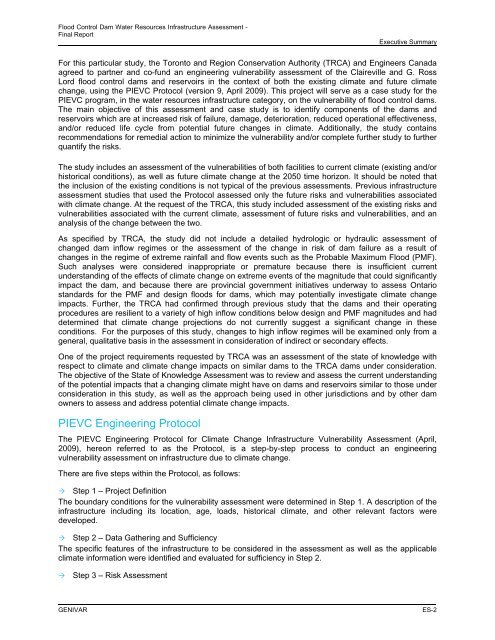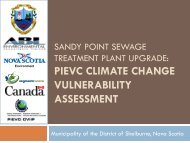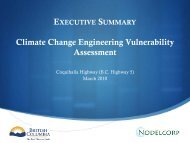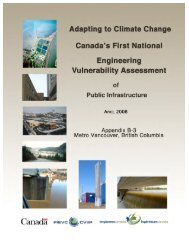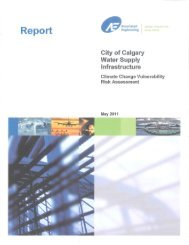Final Report - Vulnerability Committee
Final Report - Vulnerability Committee
Final Report - Vulnerability Committee
Create successful ePaper yourself
Turn your PDF publications into a flip-book with our unique Google optimized e-Paper software.
Flood Control Dam Water Resources Infrastructure Assessment -<strong>Final</strong> <strong>Report</strong>Executive SummaryFor this particular study, the Toronto and Region Conservation Authority (TRCA) and Engineers Canadaagreed to partner and co-fund an engineering vulnerability assessment of the Claireville and G. RossLord flood control dams and reservoirs in the context of both the existing climate and future climatechange, using the PIEVC Protocol (version 9, April 2009). This project will serve as a case study for thePIEVC program, in the water resources infrastructure category, on the vulnerability of flood control dams.The main objective of this assessment and case study is to identify components of the dams andreservoirs which are at increased risk of failure, damage, deterioration, reduced operational effectiveness,and/or reduced life cycle from potential future changes in climate. Additionally, the study containsrecommendations for remedial action to minimize the vulnerability and/or complete further study to furtherquantify the risks.The study includes an assessment of the vulnerabilities of both facilities to current climate (existing and/orhistorical conditions), as well as future climate change at the 2050 time horizon. It should be noted thatthe inclusion of the existing conditions is not typical of the previous assessments. Previous infrastructureassessment studies that used the Protocol assessed only the future risks and vulnerabilities associatedwith climate change. At the request of the TRCA, this study included assessment of the existing risks andvulnerabilities associated with the current climate, assessment of future risks and vulnerabilities, and ananalysis of the change between the two.As specified by TRCA, the study did not include a detailed hydrologic or hydraulic assessment ofchanged dam inflow regimes or the assessment of the change in risk of dam failure as a result ofchanges in the regime of extreme rainfall and flow events such as the Probable Maximum Flood (PMF).Such analyses were considered inappropriate or premature because there is insufficient currentunderstanding of the effects of climate change on extreme events of the magnitude that could significantlyimpact the dam, and because there are provincial government initiatives underway to assess Ontariostandards for the PMF and design floods for dams, which may potentially investigate climate changeimpacts. Further, the TRCA had confirmed through previous study that the dams and their operatingprocedures are resilient to a variety of high inflow conditions below design and PMF magnitudes and haddetermined that climate change projections do not currently suggest a significant change in theseconditions. For the purposes of this study, changes to high inflow regimes will be examined only from ageneral, qualitative basis in the assessment in consideration of indirect or secondary effects.One of the project requirements requested by TRCA was an assessment of the state of knowledge withrespect to climate and climate change impacts on similar dams to the TRCA dams under consideration.The objective of the State of Knowledge Assessment was to review and assess the current understandingof the potential impacts that a changing climate might have on dams and reservoirs similar to those underconsideration in this study, as well as the approach being used in other jurisdictions and by other damowners to assess and address potential climate change impacts.PIEVC Engineering ProtocolThe PIEVC Engineering Protocol for Climate Change Infrastructure <strong>Vulnerability</strong> Assessment (April,2009), hereon referred to as the Protocol, is a step-by-step process to conduct an engineeringvulnerability assessment on infrastructure due to climate change.There are five steps within the Protocol, as follows: Step 1 – Project DefinitionThe boundary conditions for the vulnerability assessment were determined in Step 1. A description of theinfrastructure including its location, age, loads, historical climate, and other relevant factors weredeveloped. Step 2 – Data Gathering and SufficiencyThe specific features of the infrastructure to be considered in the assessment as well as the applicableclimate information were identified and evaluated for sufficiency in Step 2.Step 3 – Risk AssessmentGENIVARES-2


